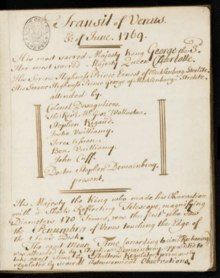Benjamin Vulliamy
Benjamin Vulliamy (1747 – 31 December 1811), was a clockmaker responsible for building the Regulator Clock, which, between 1780 and 1884, was the official regulator of time in London.[2]
Benjamin Vulliamy | |
|---|---|
 From a painting in the Science Museum, London | |
| Born | 1747 London, England |
| Died | 31 December 1811 (aged 63–64)[1] |
| Occupation | Clockmaker |
| Spouse(s) | Mary Gray Vulliamy |
| Children | Benjamin Lewis Vulliamy |
Biography

Benjamin Vulliamy was the son of Justin Vulliamy, a clockmaker of Swiss origin, who moved to London around 1730. Justin became an associate of Benjamin Gray, a watchmaker established in Pall Mall, and married Mary, a daughter of the same, with whom he had Benjamin.[2] Justin succeeded his father-in-law in the charge of the business and from 1780, his son Benjamin entered the society (Vulliamy & Son). Father and son worked together until the death of Justin, on 1 December 1797.[3]
.jpg)
From an early age, Vulliamy had shown interest in pursuing his father's career. As an adult, he began to earn a reputation as a builder of mantel clocks, decorative timepieces that adorned the halls of high society (nowadays, some can be found at the Derby Museum and Art Gallery).[4] His talent earned him a Royal Appointment in 1773, through which he came to receive an endowment of £150 a year as George III's King's Clockmaker (there was a similar distinction, Royal Watchmaker, then held by George Lindsay). The king, an enthusiast for watches and mechanical devices, was patron of Justin Vulliamy, but only Benjamin received this significant honour.[5]
Around 1780, Vulliamy was commissioned to build the Regulator Clock, the main timekeeper of the King's Observatory Kew, which served as an unofficial Prime Meridian and was responsible for the official London time until 1884, when the Greenwich Royal Observatory assumed both roles.[2] The Regulator Clock is now in the Science Museum in London.
In 1780 Benjamin Lewis Vulliamy was born; he was the last Vulliamy to dedicate himself to the family clockmaking business. None of his descendants took up the art of clockmaking, although his son, Lewis, was notable as an architect.
The Vulliamy clocks
Vulliamy clocks were of considerable value and represented the climax of technology at the time. A Vulliamy clock was presented to the Chinese emperor by the diplomatic mission of George Macartney to Beijing in 1793.[6] Vulliamy clocks were combined with fine porcelain figures to create artefacts that combined both science and art. The overall design was made by Vulliamy but he employed prize-winning sculptors such as John Deare [7], John Bacon and Charles Rossi [8] to create the figures that were influenced by contemporary French designs. The Vulliamy family used Crown Derby to make the figures from porcelain designs. One of Vulliamy's assistants, Jacques Planche, was a brother of Andrew Planche who had been involved in the early Derby Porcelain business.[9] The Vulliamy business also subcontracted much of the clocks' manufacture to other skilled artisans, and Vulliamy would only oversee and create the final adjustments before sale.[7]
Portraits
- Painting by an anonymous artist, bequeathed by B. L. Vulliamy 1854 (Science Museum, London).
- Wax portrait by R. C. Lucas, 1851 (Science Museum, London).
See also
- Vulliamy family
- Halifax Town Clock, Nova Scotia
References
- "Died". Salisbury and Winchester Journal. England. 6 January 1812. Retrieved 20 November 2016.
- Arcadian Times (ed.). "Kew Time". Archived from the original on 24 March 2012. Retrieved 21 May 2011.
- Montpellier Clocks (ed.). "Vulliamy, London. No. 220". Retrieved 21 May 2011.
- Antique-Marks (ed.). "The astronomy clock by Benjamin Vullliamy". Retrieved 21 May 2011.
- Derby City Council, ed. (2009). "Vulliamy Mantle Clock". Archived from the original on 3 November 2009. Retrieved 21 May 2011.
- William Proudfoot, Biographical Memoir of James Dinwiddie: Embracing Some Account of His Travels in China and Residence in India (Liverpool: Edward Howell, 1868), 45.
- Royal Crown Derby Gallery, Antique Marks.com. Retrieved May 2011
- Gunnis, Rupert (1968). Dictionary of British Sculptors 1660-1851. Abbey Books. OCLC 504200973.
- Tessa Murdoch, « La contribution des Huguenots au goût pour la porcelaine et à sa fabrication en Angleterre », dans Sèvres (revue de la Société des Amis du musée national de Céramique), n° 15, 2006, p. 45-46.